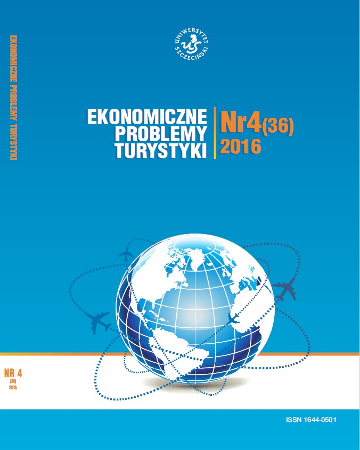
ISSN: 1644-0501
eISSN: 2353-3188
OAI
DOI: 10.18276/ept.2017.1.37-14



Issue archive /
nr 1 (37) 2017
Turystyczne regiony transgraniczne – problematyka badawcza na przykładzie granicy trzech państw (Peru, Brazylii i Kolumbii) w zachodniej Amazonii
(Tourist Cross-Border Regions – Research Issues on The Example of the Tri-Border Area Between Peru, Brazil and Colombia in the Western Amazonia)
| Authors: |
Andrzej
Czerny
Uniwersytet Marii Curie-Skłodowskiej w Lublinie Mirosława Czerny Uniwersytet Warszawski |
| Keywords: | tourism cross-border cooperation Santa Rosa Tabatinga Leticia Amazonia |
| Data publikacji całości: | 2017 |
| Page range: | 13 (181-193) |
| Klasyfikacja JEL: | R11 R58 Z32 |
Abstract
In general, cross-border cooperation brings many economic benefits for neighbour countries; and this also holds true in the specific case of tourism, whose development either side of a border can ensure increased turnover in trade, gastronomy, the hotel business and the wider sector of tourist services. Further, even more far-reaching effects can entail an improved state of infrastructure where transport and communications are concerned, as well as higher levels of income for local people. Cross-border cooperation may well be a precondition where regions involved are peripheral, in the sense that they are difficult of access as regards location, and also characterised by small and/or declining populations. What is involved here above all is a curtailment of the formal obstacles standing in the way of people’s crossing of a border, as followed up by joint efforts to develop tourism and transport. Amazonia has proved a magnet for explorers and adventurers since the time the first Europeans came there. Today, that vast region’s nature and indigenous peoples prove fascinating to a far wider group of actual and would-be tourists. Indeed, an ever-greater range of tour operators now have tourist visits to the Amazon Basin in their brochures. Travel agents likewise offer visits to towns along the River Amazon, as well as trips to the Selva. Ecotourism and ethno-tourism are likewise developing. In this paper, the authors analyse the conditioning (first and foremost the historical conditioning) that has underpinned the development of tourism in the Leticia-Tabatinga-Santa Rosa region, which is specific in that it marks the point of convergence of the borders of Colombia, Brazil and Peru.
Download file
Article file
Bibliography
| 1. | Alcaldía de Leticia ‒ Amazonas (2016). Nuestro Municipio. Indicadores. Pobrane z: http://www.leticia-amazonas.gov.co/ indicadores_anuales.shtml?apc=bexx-1-&x=1365405 (1.12.2016). |
| 2. | Amazonas. Colombia. Guia turistica (b.r.). Bogotá: Ministerio de Comercio, Industria y Turismo. |
| 3. | Bauman, Z. (2004). Życie na przemiał. Warszawa: Wyd. Literackie. |
| 4. | Carpentier, J. (2012). El turismo comunitario y sus nuevosactores: el caso de las petroleras en la Amazonia ecuatoriana. W: J.M. Valcuende del Río (red.), Amazonia. Viajeros, turistas y poblaciones indígenas. El Sausal (Tenerife): PASOS. Pobrane z: http://www.pasosonline.org /colecciones/pasos-edita/134-numero-6-amazonia-viajeros-turistasy-poblaciones-indigenas (1.12.2016). |
| 5. | Corrêa da Silva, M. (2004). O paiz do Amazonas. Manaus: Editora Valer, Governo do Estado do Amazonas, UniNorte. |
| 6. | Czerny, M. (2007). Globalizacja a rozwój. Warszawa: PWN. |
| 7. | Czerny, M., Czerny, A. (2015). The Borders or Flows Corridors? South American Dilemmas of the Cultural Heritage |
| 8. | Protection. W: K. Heffner (red.), Geographical-Political Aspects of the Transborder Conservation of Natural and |
| 9. | Cultural Heritage. Practice in the Field of the Transborder Heritage Conservation. Łódź, Opole: Państwowy Instytut Naukowy – Instytut Śląski w Opolu. |
| 10. | Ficha Triple Frontera Amazónica Brasil–Colombia–Perú (2013). Berlin: European Commission. Pobrane z: http://www. aebr.eu/files/publications/150313_Factsheet_BR-CO-PE_5.0.pdf (1.12.2016). |
| 11. | García, J.P. (2001). Cruz y arado, fusiles y discursos. La construcción de los orientes en el Perú y Bolivia. Lima: IFEA-IEP. Gobierno Regional de Loreto (2016). Pobrane z: https://www.regionloreto.gob.pe/2016/07/ page/8/ (1.12.2016). |
| 12. | ICER (2010). Informe de Coyuntura Económica Regional. Departamento del Amazonas. Bogotá: DANE. Pobrane z: http:// www.banrep.gov.co/es/contenidos/publicacion/o-2010 (1.12.2016). |
| 13. | Instituto Brasileiro de Geografia e Estatística (2016). Cidades. Informações sobre os municípios brasileiros. Amazonas. Tabatinga. Censo Demográfico 2010: Sinopse. Pobrane z: http://ibge.gov.br/cidadesat/xtras/perfil.php?lang=&codmun=130406 (1.12.2016). |
| 14. | Leticia Amazonas. Guia Turistica (2016). S. Rojas, 2013, Historia de Leticia Amazonas Colombia. Pobrane z: http://amazonasleticia.co/historia-de-leticia-amazonas-colombia/ (1.12.2016). |
| 15. | Perkmann, M. (2003). Cross-border Regions in Europe. Significance and Drivers of Regional Cross-border co-operation. European Urban and Regional Studies, 10 (2), 153–171. |
| 16. | Rodriguez, I., Aponte, J. (2008). Frontera, turismo y modernidad en el relato de la globalidad. Algunos reflejos en la |
| 17. | Amazonia. W: C.G. Zárate Botía, C. Ahumada (red.), Fronteras en la globalización: localidad, biodiversidad y comercio en la Amazonia (s. 127‒149). |
| 18. | SUFRAMA ‒ Superintendência da Zona Franca de Manaus (2016). Áreas de Livre Comércio – ALC´s – TABATINGA. Pobrane z: http://www.suframa.gov.br/suframa _descentralizadas_alcs_tabatinga.cfm (2016.12.01). |
| 19. | Zárate Botía, C.G. (2008). Surgimiento de sentidos de etnicidad, nacionalidad y transnacionalidad en la frontera |
| 20. | Amazónica de Brasil, Perú y Colombia. W: C.G. Zárate Botía, C. Ahumada (red.), Fronteras en la globalización: localidad, biodiversidad y comercio en la Amazonia (s. 105‒126). |
| 21. | Zárate Botía, C.G., Ahumada, C. (red.) (2008). Fronteras en la globalización: localidad, biodiversidad y comercio en la |
| 22. | Amazonia. Bogotá: Universidad Nacional de Colombia Sede Amazonia, Pontificia Universidad Javeriana, Fundación Konrad Adenauer. |